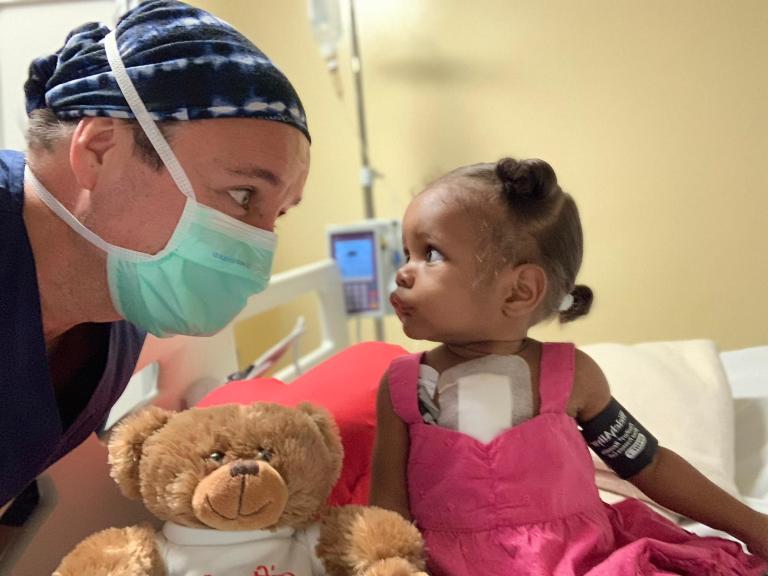
Gift of Life International was started by the humble efforts of Manhasset Rotarians in 1975, but in almost 50 years it has expanded into a global initiative with local programs across 80 countries. As the organization approaches treating its 50,000th child, a few key members are credited for its exponential growth to reach this milestone.
“To have a career where you can have a small part of touching the lives of children around the world who otherwise would not be with us today is quite amazing,” Gift of Life operations consultant Brenda Small said. “So whether it’s the first child or the 30,000th child or the 50,000th child, they’re all special. And none of those kids would be here today without all the hard work of the people in this organization.”
Founder Robbie Donno identified 2008 as a pivotal moment in Gift of Life’s history when CEO Rob Raylman was brought onto the team. Donno said Raylman contributed a global vision that was instrumental in the group’s exponential growth.
In 2012, Small was hired as the organization’s director of operations where she works alongside Rob Raylman, who was not available for comment, to develop its global programs. She joined after establishing the Gift of Life Los Angeles chapter, inspired to join the efforts after her youngest daughter was born with congenital heart disease and underwent life-saving operations within the first year of her life.
“Gift of Life Los Angeles was my own little way of giving back in honor of my own daughter,” Small said.
Between 1975 and 2008, Gift of Life treated 10,000 children. Since 2008, that number quadrupled with about 40,000 children treated in the past 13 years.
Today, the organization treats an average of 5,000 children annually.
Small attributed the exponential growth to its global cardiac programs established in developing countries, which she said has permitted greater treatment efforts.
Raylman directed the organization to expand its global efforts and maximized its impact by raising awareness in emerging countries and developing cardiac programs there.
Small said this has contributed to the growth in the number of children treated and saved since flying them to the United States for treatment is no longer their only option.
“That is a much more sustainable solution than bringing them to the U.S. one at a time,” Small said.
Gift of Life works with governments, hospitals and healthcare workers in low-income countries across the globe to help expand their programs and boost their ability to treat children with heart conditions. Small described it as “empowering” these local healthcare providers.

“A couple of the most rewarding things of doing this work is No. 1, to see the children that had no hope before have hope and have a chance at a healthy life and smiles on their faces,” Small said.
Gift of Life has expanded into 80 countries, with much of its growth occurring in the last 13 years.
“You can see how developing these pediatric cardiac care programs in the emerging world has just catapulted our impact around the world to an unbelievable level,” Small said.
Rodrigo Soto, a pediatric cardiac surgeon, joined Gift of Life in 2018 as its clinical consultant who aids its establishment of programs in developing countries. He previously served as the CEO of the International Children’s Heart Foundation and helped establish pediatric cardiac programs globally.
Soto has helped establish and develop its programs in Monterrey, Mexico; Santo Domingo in the Dominican Republic; Georgetown, Guyana; La Paz, Bolivia; Bucharest, Romania; and Cebu City, Philippines.
While he said it may seem like semantics, Soto differentiated Gift of Life’s international work from typical humanitarian visits. He described their work as training visits as they prop up the country’s local abilities to treat patients so that they can operate someday without Gift of Life’s support.
“The only way which you can actually help to solve the problem is that if you train them and they build their own capacity to do it on-site in their own country,” Soto said.
This is the case for the program in La Paz, Bolivia, which Soto said is on track to be independent by the end of September. He said that program was originally only treating three to four patients a month but now treat an average of 12 to 15.
Soto said he assembles institutional teams to work in the global programs, making three to four visits annually.
Small said what sticks with her is seeing many of these children being carried by their parents into the hospital for treatment because they don’t have the energy to walk or eat, and then be able to walk out afterward. She said it’s not only inspiring to see the smiles on the children’s faces but also the happiness of the parents.
“These parents advocate to a degree that you could not even imagine to try and save their child’s life, but there’s nothing available in their country,” Small said.
Another inspiring aspect is seeing the healthcare providers empowered and able to provide the care that they seek to give.
“All of this put together is so incredibly rewarding to see the final results when you work for years and years to develop these programs,” Small said.
Small said Gift of Life International seeks to continue the momentum it has by setting up more care programs outside of the United States and treating thousands of children annually.






